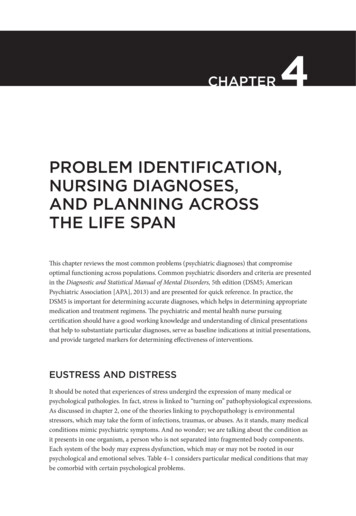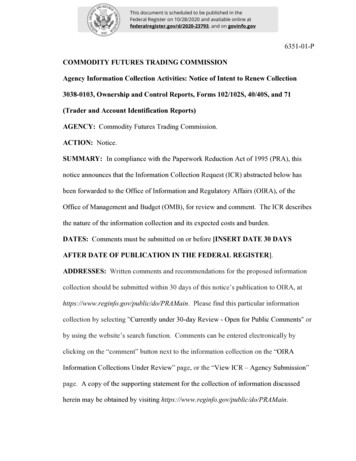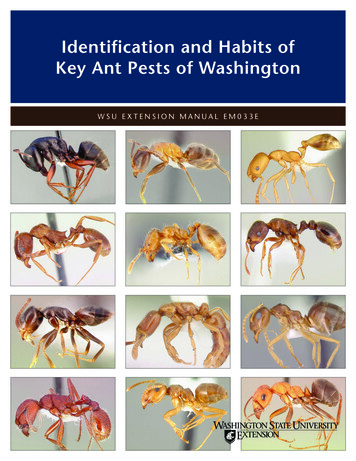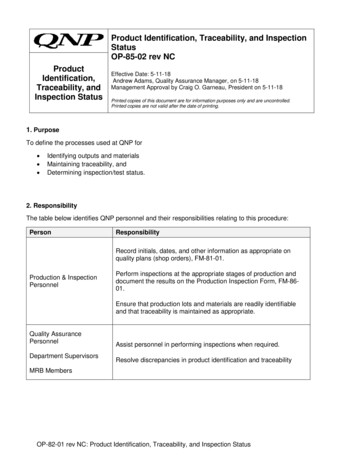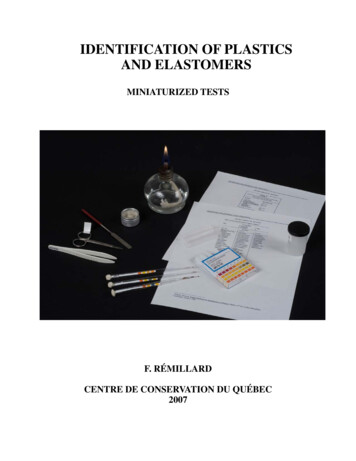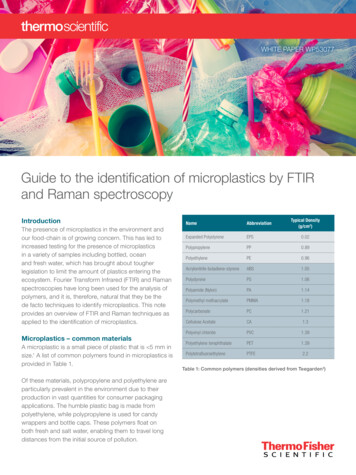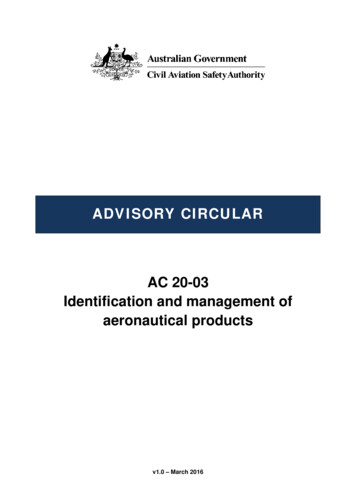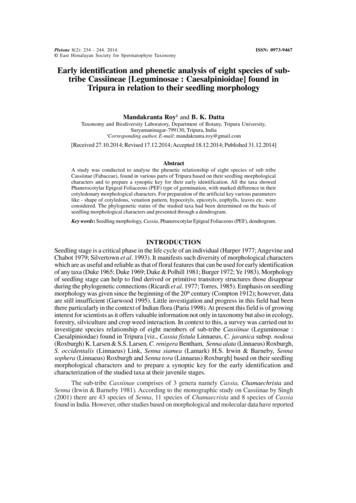
Transcription
Pleione 8(2): 234 - 244. 2014. East Himalayan Society for Spermatophyte TaxonomyISSN: 0973-9467Early identification and phenetic analysis of eight species of subtribe Cassiineae [Leguminosae : Caesalpinioidae] found inTripura in relation to their seedling morphologyMandakranta Roy1 and B. K. DattaTaxonomy and Biodiversity Laboratory, Department of Botany, Tripura University,Suryamaninagar-799130, Tripura, India1Corresponding author, E-mail: mandakranta.roy@gmail.com[Received 27.10.2014; Revised 17.12.2014; Accepted 18.12.2014; Published 31.12.2014]AbstractA study was conducted to analyse the phenetic relationship of eight species of sub tribeCassiinae (Fabaceae), found in various parts of Tripura based on their seedling morphologicalcharacters and to prepare a synoptic key for their early identification. All the taxa showedPhanerocotylar Epigeal Foliaceous (PEF) type of germination, with marked difference in theircotyledonary morphological characters. For preparation of the artificial key various parameterslike - shape of cotyledons, venation pattern, hypocotyls, epicotyls, eophylls, leaves etc. wereconsidered. The phylogenetic status of the studied taxa had been determined on the basis ofseedling morphological characters and presented through a dendrogram.Key words: Seedling morphology, Cassia, Phanerocotylar Epigeal Foliaceous (PEF), dendrogram.INTRODUCTIONSeedling stage is a critical phase in the life cycle of an individual (Harper 1977; Angevine andChabot 1979; Silvertown et al. 1993). It manifests such diversity of morphological characterswhich are as useful and reliable as that of floral features that can be used for early identificationof any taxa (Duke 1965; Duke 1969; Duke & Polhill 1981; Burger 1972; Ye 1983). Morphologyof seedling stage can help to find derived or primitive transitory structures those disappearduring the phylogenetic connections (Ricardi et al. 1977; Torres, 1985). Emphasis on seedlingmorphology was given since the beginning of the 20th century (Compton 1912); however, dataare still insufficient (Garwood 1995). Little investigation and progress in this field had beenthere particularly in the context of Indian flora (Paria 1998). At present this field is of growinginterest for scientists as it offers valuable information not only in taxonomy but also in ecology,forestry, silviculture and crop weed interaction. In context to this, a survey was carried out toinvestigate species relationship of eight members of sub-tribe Cassiinae (Leguminosae :Caesalpinioidae) found in Tripura [viz., Cassia fistula Linnaeus, C. javanica subsp. nodosa(Roxburgh) K. Larsen & S.S. Larsen, C. renigera Bentham, Senna alata (Linnaeus) Roxburgh,S. occidentalis (Linnaeus) Link, Senna siamea (Lamark) H.S. Irwin & Barneby, Sennasophera (Linnaeus) Roxburgh and Senna tora (Linnaeus) Roxburgh] based on their seedlingmorphological characters and to prepare a synoptic key for the early identification andcharacterization of the studied taxa at their juvenile stages.The sub-tribe Cassiinae comprises of 3 genera namely Cassia, Chamaechrista andSenna (Irwin & Barneby 1981). According to the monographic study on Cassiinae by Singh(2001) there are 43 species of Senna, 11 species of Chamaecrista and 8 species of Cassiafound in India. However, other studies based on morphological and molecular data have reported
Mandakranta Roy & B.K. Datta235that the monophyletic relationship among Cassia, Chamaecrista and Senna remains unclear(Doyle et al. 2000; Bruneau et al. 2001; Kajita et al. 2001). According to Deb (1981), there are9 species of sub-tribe Cassiinae found in Tripura belonging to two genera Cassia and Senna,namely Cassia fistula, C. javanica ssp. nodosa, C. renigera, Senna alata, S. occidentalis,S. siamea, S. sophera, S. tora and S. timorensis. They are frequently occurring both in wildas well as in cultivated condition at almost all parts of the state. Out of them 2 are undershrubs[S. occidentalis and S. tora], 2 shrubs [S. alata and S. sophera] and the rest 5 are trees [C.fistula, C. javanica ssp. nodosa, C. renigera, S. siamea and S. timorensis]. S. siamea andS. fistula are most commonly available trees and S. timorensis being one of the rarest amongCassiinae in Tripura, no record of it was obtained during the present survey.The members of Cassiinae found in Tripura have a wide range of importance. Theypossess a significant amount of medicinal properties and a few among them are of greateconomic importance. Senna siamea and Cassia fistula are commonly found as avenuetrees and are also planted in tea gardens for shade and to maintain soil nitrogen. The leavesof Senna alata are exclusively used by the Chakma and Darlong tribal communities ofTripura in the treatment of ringworm infections (Deb et al. 2012; Oladele et al. 2010). It hasalso been reported in the treatment of leprosy and syphilis (Kritikar & Basu 1935). The useof Senna sophera leaves as an antidote for snake bites is well documented in the Indianliterature (Kritikar & Basu 1935). Cassia fistula, also known as the Golden Shower tree forits beautiful yellow showy flowers, is well known in Ayurvedic medicine as aragvadha(“disease killer”). It has hepatoprotective, anti-inflammatory, antitussive, antibacterial,antifungal activities and is also used in wound healing (Gupta 2010). The seed extracts ofCassia javanica ssp. nodosa has effective purgative nature and haemagglutinating activityand the seed gum has rheological activity (Goncalves et al. 2004). The leaves and flowers ofSenna occidentalis are edible and the infusion of leaves has long been used as an effectivemedicine for the treatment of hepatitis in rainforests (Nuhu & Alio 2008). Cassia renigeraalso known as Burmese pink cassia is a rich source of flavonoids and anthraquinones (CSIR1992). A study on free radical scavenging activity screening of medicinal plants from Tripurashowed a positive result of antioxidant activity of stems of Cassia javanica ssp. nodosaand Cassia renigera (Kshirsagar & Upadhyay 2009). The alcoholic extract of flowers ofSenna siamea has a potent antioxidant activity against free radicals and affords significantprotection against oxidative damage in liver (Kaur et al. 2006). Senna tora is traditionallyused as laxative, for the treatment of leprosy and various skin disorders and is also effectiveagainst free radical mediated diseases (Rejiya et al. 2009).So far no synoptic key has been constructed for the flora of Tripura, based on seedlingmorphological characters. Therefore, the key prepared in the present study is completely anew initiative in Tripura for the early identification and conservation of the studied taxa. Thephenogram presented in this study is the first report of implication of seedling morphologicalcharacters in phenetic analysis of the members of the sub-tribe Cassiinae found in Tripura.MATERIALS AND METHODIn the present investigation, seedlings of various stages of eight species of sub-tribe Cassiinaefound in Tripura viz., Cassia fistula, Cassia javanica ssp. nodosa, Cassia renigera, Sennaalata, Senna occidentalis, Senna siamea, Senna sophera and Senna tora were collectedfrom different areas of the state and identified by comparing with the seedlings raised fromidentified seeds in the experimental garden. For seedling morphological study, the terminologiesproposed by Burger (1972), Hickey (1973), Bokdam (1977) and Vogel (1980) were followed.
236Seedling morphology of sub-tribe CassiineaeFor diagnosis of seedlings characters like cotyledon, eophyll, hypocotyl, etc. the method ofVogel (1980), and Das & Paria (1999) were taken into consideration. The seedling specimensrepresenting the different stages of development were dried and preserved as herbariumvouchers in Tripura University Herbarium.Taking the seedling characters into count an artificial key was constructed for theearly identification of the investigated taxa. Numerical evaluation of seedling morphologicalcharacters for determining phenetic relationships among the investigated taxa had been donethrough cluster analysis which is represented by Phenograms constructed by different linkagemethods such as Unweighted Pair Group Method of Arithmetic Average (UPGMA) andSingle Linkage with the assistance of PAST software program to draw affinities betweenthe investigated taxa as far as practicable. The characters used for the cluster analysis wererepresented in the form of a comparative table (Table 1).RESULTDetails of the investigation of seedling morphology on the plants under Cassiinae from Tripuraare presented in Table 1.Table 1. Comparative analyses of the morphological characteristics of the studied seedlings [Abbreviations used: ac: acute; act: actinodromous; apc: apiculate; asym rnd: asymmetrically round; aur: auriculate; brd lan: broad lanceolate; cun: cuneate; del: deltoid;ellip: elliptic; lan: lanceolate; lin: linear; muc: mucronate; obl: oblong; obl obv: oblongobovate; obl orb: oblong orbicular; obl ov: oblong ovate; oblq: oblique; oblq trunc: obliquely truncate; obv: obovate; orb: orbicular; ov: ovate; pcot: paracotyledon; PEF:Phenerocotylar Epigeous Foliaceous; ren: reniform; rnd: round; rtnd: rotund; st-g: straightglabrous; st-h: Straight-hairy; st-h*: straight- characteristic white hairs, up to 0.3cm longand perpendicular to stem; slght ntchd: slightly notched]Name of the taxaSeedling charactersSeedlingtypeHypo- StipulecotylCassia fistula Linnaeus [Roy & Datta105] Fig. 1(b-c).PEFSt-hdelCotyledons /ParacotyledonsType Shape No. ofprimaryveins,venationpatternpcotobv5, actCassia javanica ssp. nodosa (Roxburgh)K. Larsen & S.S. Larsen [Roy & Datta112] Fig. 1(d-f).Cassia renigera Bentham [Roy & Datta122] Fig. 1(j-k).PEFSt- glinpcotoblPEFSt-hrenpcotSenna alata (Linnaeus) Roxburgh (Roy &Datta 081] Fig. 1(a).PEFSt- haurSenna occidentalis (Linnaeus) Link [Roy& Datta 092] Fig. 1(g-i).Senna siamea (Lamark) H.S. Irwin &Barneby [Roy & Datta 105] Fig. 1(l-m).Senna sophera (Linnaeus) Roxburgh [Roy& Datta 097] Fig. 1(n).Senna tora (Linnaeus) Roxburgh [Roy &Datta 099] (Fig. 1(o-p).PEFSt- h*PEFEophyllShape Apex, baseovac, rnd3, actoblmuc, oblqtruncoblov3, actoblovmuc, oblqtruncpcotrnd7, actoblobvlinpcot5, borbrnd – slghtntchd,oblqapc, rtndPEFSt-hlinpcotorb5, act5, act5, actobl lanobvmuc, asymrndac, oblqapc, cun
Mandakranta Roy & B.K. Datta237Based on the seedling morphological characters a dichotomous key has been constructed tofacilitate the identification of these plants in their natural habitat. The Key is presentedbelow:Key to the plants of Cassiinae of Tripura1a. Primary veins of cotyledons 3, stipules reniform, leaflets in 4 - 6 pairs in eophylls . 21b. Primary veins of cotyledon more than 3, stipules never reniform, leaflets in 2- 3pairs in eophylls. 32a. Paracotyledons sessile, leaflets oblanceolate with blunt acuminate apex . .Cassia javanica ssp. nodosa2b. Paracotyledons with petioles 0.1cm long; leaflets oblong ovate with acute apex. . . Cassia renigera3a. Petiolules never orange, primary veins 5 in cotyledons, stipules not auriculate . 43b. Petiolules characteristically orange, primary veins 7 in cotyledons, stipule auriculate . . Senna alata4a. Cotyledons 0.1 cm thick initially, leathery later, stipules deltoid, leaflets up to 8 cm longat higher stages . . .Cassia fistula4b. Cotyledons always membranous, stipules linear, leaflets not more than 6 cm long athigher stages. 55a. Stem with reddish yellow lenticels; lamina elliptic, reddish brown tinged, midribbifurcated at 2/3 length of the cotyledon and forming continuation with the adjacentprimary nerves forming a characteristic heart shape . Senna siamea5b. Lenticels never reddish brown, lamina not elliptic, always green, never reddish browntinged, midrib not forming any characteristic heart shape on cotyledon . 66a. Stem with characteristic white simple hairs up to 0.3 cm arranged perpendicular to thestem, leaflets ovate-lanceolate, base rotund . . Senna occidentalis6b. Hairs if present very short, simple, colourless, up to 0.1 cm long, leaflets obovate oroblonglanceolate, base not rotund .77a. Leaflets oblong, lanceolate later, acute, base oblique . Senna sophera7b. Leaflets obovate, apiculate, base cuneate. Senna toraDISCUSSIONThe eight investigated species of sub-tribe Cassiinae [Leguminosae : Caesalpinioidae] inTripura, namely Cassia fistula (Fig. 1b), Cassia javanica ssp. nodosa (Fig. 1d), Cassiarenigera (Fig. 1j), Senna alata (Fig. 1a), Senna occidentalis (Fig. 1g), Senna siamea(Fig. 1l), Senna sophera (Fig.1n) and Senna tora (Fig. 1o) were characterised by someimportant seedling morphological features which can serve as marker characters foridentification of the taxa at species level. It was observed that all the eight studied speciesshowed Phanerocotylar Epigeal Foliaceous (PEF) type of germination. PEF type ofgermination is advantageous over other types in many ways. Seedlings with PEF type ofgermination generally grow faster than seedlings with other types when they were exposedto increased light (Pooma & Bongers 1988). Such germination produce seedlings with highermaximum photosynthetic rates than Cryptocotylar Epigeal Reserve (CHR) type (StraussDebene-detti & Bazzaz 1991). According to Hladik & Miquel (1990), Garwood (1996),Kitajima (1996) and Green & Juniper (2004b), functional morphology of cotyledon determineshow the resources are used during initial seedling growth and development which in
(“disease killer”). It has hepatoprotective, anti-inflammatory, antitussive, antibacterial, antifungal activities and is also used in wound healing (Gupta 2010). The seed extracts of Cassia javanica ssp. nodosa has effective purgative nature and haemagglutinating activity and the seed gum has rheological activity (Goncalves et al. 2004). The leaves and flowers of Senna occidentalis are .



